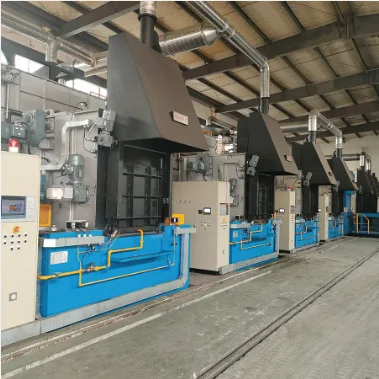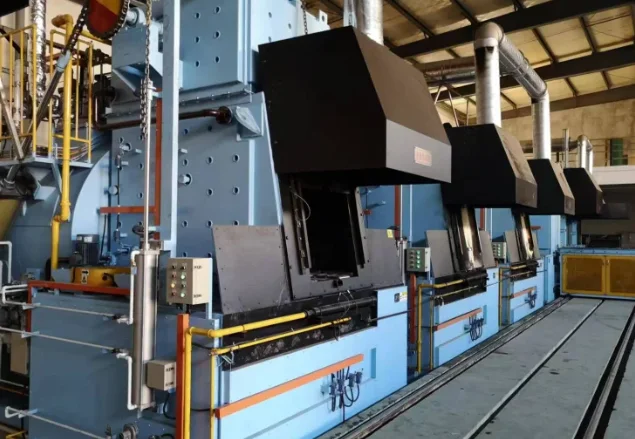Tempering furnaces play a vital role in various industries, providing controlled heating and cooling processes to increase the strength and durability of materials. Whether you are in the manufacturing, construction or even automotive industry, understanding the different types of tempering furnaces and their customization options is critical to optimizing your production process and achieving superior results.
In this comprehensive guide, we’ll take a deep dive into the world of tempering furnaces, exploring the various types available and the customization options that can be customized to meet your specific needs. Each type has unique advantages and considerations, allowing you to choose the option that best suits your application. Additionally, we'll explore the customization options available, such as temperature control, atmosphere adjustment, and dimensional changes, allowing you to fine-tune your tempering furnace for precise and consistent results.
Whether you are a seasoned professional or new to the field, this guide is designed to provide you with a solid foundation of knowledge about tempering furnaces, allowing you to make informed decisions and optimize your production processes. So let’s dive into the fascinating world of tempering furnaces, revealing the types and customization options that can take your materials’ strength and performance to new heights.
Overview of Tempering Furnace Types
Electric Tempering Furnaces
Electric tempering furnaces are widely used for their efficiency and precise temperature control. They operate by heating elements that transfer heat to the chamber, ensuring uniform heating.
These furnaces are ideal for small to medium-sized parts and offer quick heating and cooling cycles. Their compact size makes them suitable for various industries, including automotive and aerospace.
Gas-fired Tempering Furnaces
Gas-fired tempering furnaces rely on burners to heat the chamber, providing a cost-effective solution for large-scale production. The burners maintain consistent temperatures required for the tempering process.
With their ability to handle heavy workloads, gas-fired furnaces are commonly found in steel mills and metal fabrication plants. They offer high throughput rates, making them efficient for bulk processing.
Salt Bath Tempering Furnaces
Salt bath tempering furnaces use molten salt as a heating medium to achieve rapid and uniform heating. These furnaces are known for their excellent heat transfer properties, ensuring consistent results across all parts.
The immersion of components in the salt bath allows for precise temperature control, making it suitable for delicate parts requiring specific heat treatment. Their versatility extends to various applications in tool manufacturing and precision engineering.
Key Benefits of Using Tempering Furnaces
-
Enhanced Strength: Tempering furnaces improve the toughness and durability of materials by reducing internal stresses.
-
Uniform Heating: These furnaces ensure even distribution of heat throughout the workpiece, minimizing distortion.
-
Cost Efficiency: By optimizing energy consumption and reducing scrap rates, tempering furnaces offer cost-effective heat treatment solutions.
-
Versatility: Different types of tempering furnaces cater to a wide range of industries with varying needs.
-
Quality Control: The precise temperature regulation provided by these furnaces ensures consistent quality in the tempered parts.
Pit Furnace Advantages
Versatility
Pit furnaces offer several advantages in heat treatment processes. One key benefit is their versatility. These furnaces can accommodate a wide range of materials, from small components to large parts, making them suitable for various industries.
Pit furnaces are highly adaptable, allowing for the processing of different types of materials such as steel, aluminum, and copper alloys. This versatility makes them ideal for heat treating applications across diverse sectors, including automotive, aerospace, and manufacturing.
Energy Efficiency
One significant advantage of pit furnaces is their energy efficiency. These furnaces are designed to minimize heat loss during operation, leading to lower energy consumption and cost savings for businesses. By retaining heat effectively, pit furnaces ensure optimal temperature uniformity throughout the heating process.
-
Reduced energy consumption
-
Cost savings for businesses
Safety Considerations
When using pit furnaces, it is essential to prioritize safety considerations. Due to the high temperatures involved in the heat treatment process, operators must adhere to strict safety protocols to prevent accidents and ensure a secure working environment.
-
Adherence to safety protocols
-
Preventing accidents during operation
Uniform Heating
Pit furnaces provide uniform heating, ensuring consistent temperature distribution within the furnace chamber. This uniformity is crucial for achieving precise heat treatment results and maintaining the quality and integrity of the processed materials.
-
Consistent temperature distribution
-
Precise heat treatment results

Vacuum Temper Furnace Specifications
Overview
Vacuum temper furnaces are designed to achieve precise temperature control during the tempering process. These furnaces utilize a vacuum environment to heat treat materials effectively. The specifications of these furnaces play a crucial role in ensuring the quality and consistency of tempered products.
Temperature Control
Temperature control is a key feature of vacuum temper furnaces, with the ability to reach temperatures up to 1500°C. This precise control allows for the transformation of material properties without the risk of oxidation or contamination. The uniform heating distribution within the vacuum chamber ensures consistent results across all parts.
Heating Elements
The heating elements in vacuum temper furnaces are typically made of high-quality materials like graphite or refractory metals. These elements provide efficient heat transfer and maintain stability at high temperatures, contributing to the overall reliability and performance of the furnace.
Cooling System
A sophisticated cooling system is integrated into vacuum temper furnaces to facilitate rapid quenching after the tempering process. This controlled cooling prevents distortion or cracking of the material while enhancing its mechanical properties such as hardness and toughness.
Importance of Vacuum Technology
The utilization of vacuum technology in tempering processes offers several advantages. By creating a low-pressure environment, vacuum temper furnaces eliminate impurities and prevent surface reactions, leading to cleaner and more durable end products. The absence of air ensures uniform heating and minimizes decarburization risks.
Quality Control Measures
Quality control is paramount in heat treatment processes, and vacuum temper furnaces enable stringent quality control measures. Through precise temperature regulation and monitoring systems, these furnaces ensure that each component undergoes consistent and reliable heat treatment, meeting strict industry standards for hardness, strength, and dimensional accuracy.
Pros:
-
Precise temperature control
-
Uniform heating distribution
-
Enhanced mechanical properties
Customizing Your Tempering Furnace
Heating Elements
When customizing tempering furnaces, selecting the appropriate heating elements is crucial. Options include electric resistance heaters or gas-fired burners. Each has its advantages, with electric heaters offering precise temperature control and gas burners providing rapid heating capabilities.
Gas-fired burners are often preferred for their quick ramp-up times, making them ideal for high-volume production environments. On the other hand, electric resistance heaters are known for their energy efficiency and uniform heat distribution across the furnace chamber.
Controls and Monitoring
Customizing tempering furnaces also involves choosing the right control system. Options range from basic manual controls to advanced programmable logic controllers (PLCs) with touchscreen interfaces. PLCs offer enhanced automation capabilities, allowing for precise temperature regulation and real-time monitoring of key parameters.
Integrating a sophisticated control system enables operators to adjust settings remotely, track process data for quality control purposes, and receive alerts in case of any deviations from set parameters.
Advantages of Customization
Tailoring your tempering furnace to meet specific industrial requirements offers several advantages. By customizing the heating elements and controls, businesses can achieve optimal thermal performance, ensuring consistent heat treatment results.
Customized furnaces also enhance operational efficiency by streamlining production processes and reducing downtime associated with equipment malfunctions or subpar performance. Tailored solutions can improve product quality and overall throughput, leading to increased customer satisfaction and higher profitability for businesses.

Summary
The overview of tempering furnace types, advantages of pit furnaces, vacuum temper furnace specifications, and customization options have shed light on the diverse aspects of these crucial industrial tools. Understanding the nuances of each type empowers suppliers to cater to a wide range of client needs effectively. With this knowledge, suppliers can offer tailored solutions that enhance efficiency and quality in various manufacturing processes.
To stay competitive in the market, it is essential for suppliers to continuously update their knowledge on tempering furnaces and adapt to evolving industry requirements. By leveraging the insights gained from this article, suppliers can refine their offerings, provide exceptional service, and forge lasting partnerships with clients seeking top-notch tempering furnace solutions.
Frequently Asked Questions
What are the common types of tempering furnaces available in the market?
Tempering furnaces commonly come in pit furnace, vacuum temper furnace, and customizable options to suit various industrial needs.
How do pit furnaces stand out as a choice for tempering processes?
Pit furnaces offer advantages like uniform heating, energy efficiency, and easy loading/unloading due to their design.
What are the typical specifications of a vacuum temper furnace?
Vacuum temper furnaces usually operate under specific temperature ranges and pressure conditions to achieve precise heat treatment results.
Can you customize a tempering furnace according to specific requirements?
Yes, tempering furnaces can be customized in terms of size, heating elements, controls, and other features to meet individual manufacturing needs.






